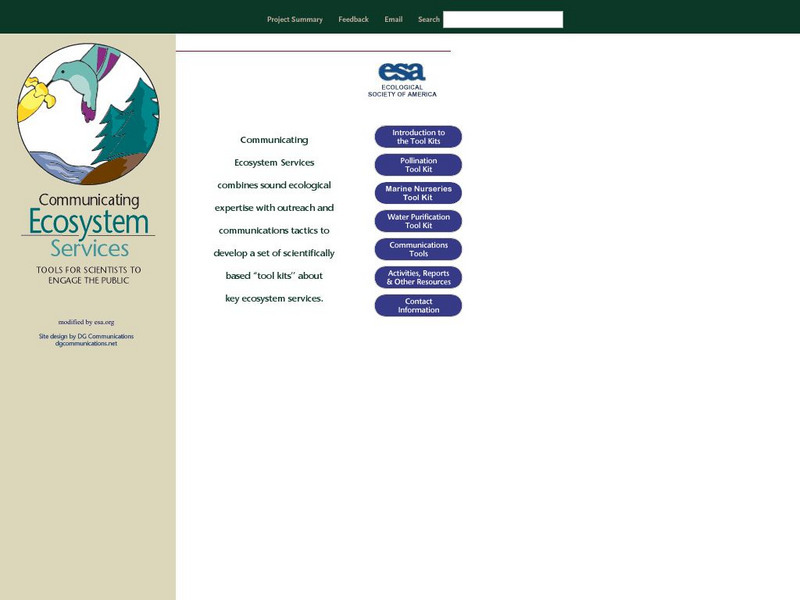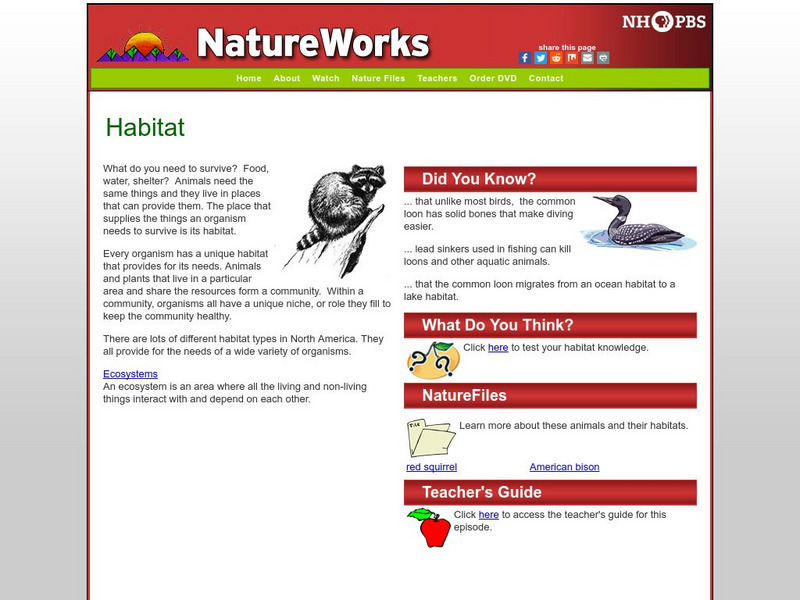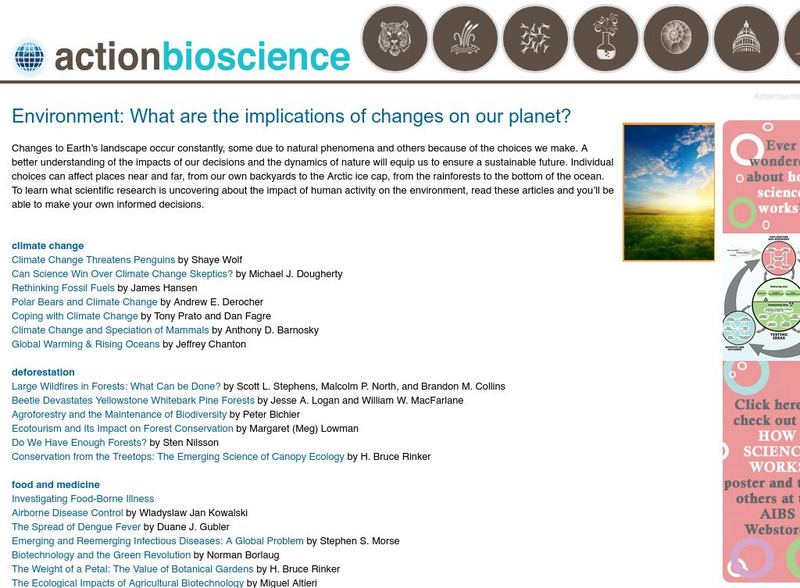Other
Ecological Society of America: Communicating Ecosystem Services
A large collection of resources to aid professionals, community members, and educators in communicating the role and importance of ecosystem services. Issues addressed include pollination, marine nurseries, and water purification....
PBS
Nh Pbs: Nature Works: Habitat
What do you need to survive? Food, water, shelter? Animals need the same things and they live in places that can provide them. This informative site looks at the characteristics, range, habitat, food, reproduction and behavior of the red...
Nature Conservancy
The Nature Conservancy: From America's Rainforest to America's Desert
On this virtual field trip, teachers will help their young scholars travel to the lush, rain-soaked splendor of the Olympic Peninsula and explore the urban watershed of Seattle. Next, they will head to Arizona's dry, desert landscape and...
TeachEngineering
Teach Engineering: Biodomes
Students explore the biosphere's environments and ecosystems, learning along the way about the plants, animals, resources and natural cycles of our planet. Over the course of lessons 2-6, students use their growing understanding of...
American Institute of Biological Sciences
Action Bioscience: Ecosystem Services: A Primer
It is humans' responsibility to take care of the Earth's many ecosystems. Many of the daily things we take for granted - e.g., clean water and air, pest control, and protection from severe weather - are results of healthy ecosystems....
BSCS Science Learning
Bscs: Frog Eat Frog World
Using maps and graphs of large data sets collected in FrogWatch, students will determine the range, preferred land cover, and proximity to water of the American bullfrog to figure out the bullfrog's requirements for food, water, and...
US Environmental Protection Agency
Epa: Conservation
Official site with information and resources relating to all aspects of environmental conservation: data, maps and laws. Specific environmental information by zip code provides immediate relevance to your world.
TeachEngineering
Teach Engineering: Go With the Energy Flow
Students learn about energy and nutrient flow in various biosphere climates and environments. They learn about herbivores, carnivores, omnivores, food chains and food webs, seeing the interdependence between producers, consumers and...
PBS
Pbs Learning Media: Center Card: Build an Animal Habitat
Children design an animal habitat and talk about how the habitat provides the animal's basic needs -- shelter, water, and food -- using this block center activity. It includes three resources.
Next.cc
Next: Biomes
Multiple activities help students gain a better understanding of land and water biomes.
Smithsonian Institution
Smithsonian Science Education Center: Showbiz Safari
Lights! Camera! Action! Our movie director needs your help! Help Walrus pick actors based on the traits that best fit the movie role. Which furry mammal will get the most wanted role in the blockbuster film "Paws"? Which water loving...
CK-12 Foundation
Ck 12: Life Science: Aquatic Biomes
[Free Registration/Login may be required to access all resource tools.] Aquatic biomes can be generally classified based on the amount of salt in the water. Freshwater biomes have less than 1% salt and are typical of ponds and lakes,...
PBS
Pbs Nature: Penguins
Did you know that penguins can survive for more than 100 days without food or water? Discover more educational facts about these fascinating birds when you explore this site.
TED Talks
Ted: Ted Ed: What's So Great About the Great Lakes?
The North American Great Lakes- Huron, Ontario, Michigan, Erie, and Superior- are so big that they border 8 states and contain 23 quadrillion liters of water. They span forest, grassland, and wetland habitats, supporting a region that's...
Khan Academy
Khan Academy: The Economics of Pollution
Pollution is an example of a negative externality. Despite the gradual reduction in emissions from fossil fuels, many important environmental issues remain. Along with the still-high levels of air and water pollution, other issues...
PBS
Nh Pbs: Nature Works: Estuaries
Learn more about estuaries when you visit this informative site. This resource provides locations of and weblinks to estuaries in the United States.
Government of Canada
Government of Canada: Environment: Ecosystem Initiatives
This resource provides information on ecosystem initiatives and the programs in Canada that are working to preserve area ecosystems.
American Institute of Biological Sciences
Action Bioscience: Issues in Environment
This site from American Institute of Biological Sciences provides a collection of articles on current issues in environmental science and human impacts on the environment. Several articles available in Spanish.
abcteach
Abcteach: Ponds
[Free Registration/Login Required] The abcteach directory contains sample pages from their pond unit for non-members. Handouts are in PDF format.
Friends of Algonquin Park
The Science Behind Algonquin's Animals: Spruce Bogs
A Spruce bog is a northern type of habitat and is formed between small bodies of water and forests. Learn about a Spruce bog in Algonquin part and view a panorama movie of the bog.
Other
Explore Learning: Effect of Environment on New Life Form
Using the scientific method, control the environmental conditions for a fictional alien organism in order to learn how the organism responds to changes in conditions. Sunlight, water, and temperature can be varied to determine their...
The Franklin Institute
The Franklin Institute: Treasures at Sea
Learn about ocean systems and habitats. Lots of reading, writing, games, and interactive activities. Colorful and fun.
PBS
Pbs Nature: Sharks
How many species of sharks are there in the world of water? Students will discover how and where sharks live, what they eat and how they socialize through the exploration of this resource.
PBS
Nh Pbs: Nature Works: Ecosystems
How would you define an ecosystem? Check out this educational resource to learn more about the living and nonliving parts of different ecosystems.
Other popular searches
- Animals Water Habitats
- Animal Water Habitats
- Land or Water Habitats
- Shallow Water Habitats
- Water Habitats Lesson Plans
- Describe Water Habitats
- Water Habitats Rivers























